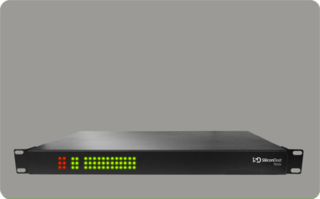
DISH Network Corporation is an American television provider and the owner of the direct-broadcast satellite provider Dish, commonly known as Dish Network, and the over-the-top IPTV service, Sling TV. Additionally, Dish offers mobile wireless service, Dish Wireless. On July 1, 2020, Dish acquired prepaid service Boost Mobile and added postpaid service Boost Infinite on December 7, 2022. Based in unincorporated Douglas County, Colorado, the company has approximately 16,000 employees. As of 2024, the company is owned by EchoStar.
A digital video recorder (DVR) is an electronic device that records video in a digital format to a disk drive, USB flash drive, SD memory card, SSD or other local or networked mass storage device. The term includes set-top boxes (STB) with direct to disk recording, portable media players and TV gateways with recording capability, and digital camcorders. Personal computers are often connected to video capture devices and used as DVRs; in such cases the application software used to record video is an integral part of the DVR. Many DVRs are classified as consumer electronic devices; such devices may alternatively be referred to as personal video recorders (PVRs), particularly in Canada. Similar small devices with built-in displays and SSD support may be used for professional film or video production, as these recorders often do not have the limitations that built-in recorders in cameras have, offering wider codec support, the removal of recording time limitations and higher bitrates.

A home theater PC (HTPC) or media center computer is a convergent device that combines some or all the capabilities of a personal computer with a software application that focuses on video, photo, audio playback, and sometimes video recording functionality. Since the mid-2000s, other types of consumer electronics, including game consoles and dedicated media devices, have crossed over to manage video and music content. The term "media center" also refers to specialized application software designed to run on standard personal computers.

Moxi was a line of high-definition digital video recorders produced by Moxi Digital Digeo and Arris International. Moxi was originally released only to cable operators, but in December 2008 it was released as a retail product. Moxi was removed from the market in November 2011. The former retail product, the Moxi HD DVR, provided a high-definition user interface with support for either two or three CableCARD TV tuners. Arris also offered a companion appliance, the Moxi Mate, which could stream live or recorded TV from a Moxi HD DVR.
Now is a subscription over-the-top streaming television service operated by British satellite television provider Sky Group. Launched in the United Kingdom in 2012, the service is also available in Ireland, Italy, Germany, Austria (as SkyX, Switzerland and the United States.

The Slingbox was a TV streaming media device made by Sling Media that encoded local video for transmission over the Internet to a remote device. It allowed users to remotely view and control their cable, satellite, or digital video recorder (DVR) system at home from a remote Internet-connected personal computer, smartphone, or tablet as if they were at home.
ESPN3 is an online streaming service owned by ESPN Inc., a joint venture between The Walt Disney Company and Hearst Communications, that provides live streams and replays of global sports events to sports fans in the United States.
Orb was a freeware streaming software that enabled users to remotely access all their personal digital media files including pictures, music, videos and television. It could be used from any Internet-enabled device, including laptops, pocket PC, smartphones, PS3, Xbox 360 and Wii video game consoles.

HDHomeRun is a network-attached digital television tuner box, produced by the company SiliconDust USA, Inc.
Monsoon Multimedia was a company that manufactured, developed and sold video streaming and place-shifting devices that allowed consumers to view and control live television on PCs connected to a local (home) network or remotely from a broadband-connected PC or mobile phone. It was one of 5 major transformations initiated by Prabhat Jain, a Silicon Valley entrepreneur with 5 undergraduate and post graduate engineering degrees from Cal Berkeley and Univ of Vienna, Austria. On the even of Cisco acquiring Monsoon in 2017, EchoStar, the new parent of Sling sued Monsoon for patent infringement, having obtained confidential information about the date of the acquisition by Cisco from a Monsoon employee under murky circumstances. Monsoon settled the lawsuit by agreeing not to sell its products in the USA simply because it did not have the legal funds to fight mighty Echostar's legal maneuvers. EchoStar thus successfully removed its only competitor from the market place. This meant Monsoon's death knell.

Freeview is the brand name of the digital terrestrial television platform in Australia intended to bring all of free-to-air (FTA) broadcasters onto a consistent marketing platform, to compete against subscription television, in particular Foxtel. The strategy coincided with the expansion to 3 digital channels for each FTA network and the planned phasing out of analog television in Australia. Important services from Freeview include its free-to-air channels with an enhanced EPG across all channels. Freeview also certifies televisions, set-top boxes and personal video recorders (PVR) which meet its standards.
Clicker was an Internet video directory and search company based in Los Angeles, California. Their website aimed to be the TV Guide for all full episodes of programs available to watch on the Web. It is owned by CBS Interactive.

Google TV was a smart TV operating system from Google co-developed by Intel, Sony and Logitech. It launched in October 2010 with official devices initially made by Sony and Logitech. Google TV integrated the Android 3.0/3.2 operating system and the Google Chrome web browser to create an interactive television overlay on top of existing online video sites to add a 10-foot user interface, for a smart TV experience.

SAT>IP specifies an IP-based client–server communication protocol for a TV gateway in which SAT>IP servers, connected to one or more DVB broadcast sources, send the program selected and requested by an SAT>IP client over an IP-based local area network in either unicast for the one requesting client or multicast in one datastream for several SAT>IP clients.

Hopper is a line of digital video recording (DVR) set-top boxes offered by the U.S. direct-broadcast satellite television provider Dish Network. First introduced at Consumer Electronics Show in January 2012, the Hopper was released in March 2012 as a component of the provider's whole-home DVR system, which networks the main Hopper unit with smaller "Joey" set-top boxes to form a client-server architecture.

Roku is a brand of smart TV operating systems, smart TVs, streaming devices, smart home and audio products designed and marketed by Roku, Inc. headquartered in San Jose, CA. Roku's smart TV products primarily offer access to streaming media content from online services.
The Nexus Player was a digital media player co-developed by Google, Intel and Asus. It was the second media player in the Google Nexus family of consumer devices. Originally running the Android 5.0 ("Lollipop") operating system, it was the first device to employ the Android TV platform. The Nexus player supports Google Cast, the feature for selecting and controlling media playback on a television that was first introduced by Chromecast. Sales of the Nexus Player were discontinued in May 2016, and product support ended in March 2018.

Sling TV is an American streaming television service operated by Sling TV LLC, a wholly-owned subsidiary of Dish Network. Unveiled on January 5, 2015, at the Consumer Electronics Show, the virtual multichannel video programming distributor aims to complement subscription video on demand services for cord cutters, offering a selection of major cable channels and OTT-originated services that can be streamed through smart TVs, digital media players and apps. The service is available in the United States and Puerto Rico as of 2015.
HBO Now was an American subscription video on demand streaming service for premium television network HBO owned by WarnerMedia subsidiary Home Box Office, Inc. Officially unveiled on March 9 and launched on April 7, 2015 the service allows subscribers on-demand access to HBO's library of original programs, films and other content on personal computers, smartphones, tablet devices and digital media players. Unlike HBO Go, HBO's online video on demand service for existing subscribers of the linear television channel, HBO Now was available as a standalone service and does not require a television subscription to use, targeting cord cutters who use competing services such as Netflix and Hulu. As of February 2018, HBO Now had 5 million subscribers.

Sky Q is a subscription-based television and entertainment service operated by British satellite television provider Sky, as a part of its operations in Austria and Germany, Ireland, Italy and in the UK. The name also refers to the Sky Q set-top box.












